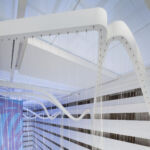Conrad New York: Redefining Hotel Atriums by MPdL Studio
Project's Summary
The Conrad New York project represents a significant evolution in the architectural landscape of hotel design, specifically focusing on the multistory atrium typology that has long dominated the hospitality sector. MPdL Studio has ingeniously transformed an existing 16-story atrium lobby, which was built in the late 1990s and featured a prominent Sol LeWitt drawing. This innovative design aims to enhance the grandeur of the atrium while addressing the common pitfalls of these spaces, which often feel vacuous and uninviting. By implementing a series of suspended 'veils,' the architects have created an atmospheric effect that not only fills the space but also gives the illusion of expansion, thus redefining the user experience in this iconic hotel lobby.

The design features a remarkable installation of steel rings that suspend translucent liquid crystal polymer fiber, stretching over 100 feet to connect various elements of the space. This intricate system not only defines a virtual lower ceiling plane but also relates the individual components to the monumental scale of the atrium. The strategic positioning of these veils creates visual interest and complexity, drawing the eye upward and enhancing the overall grandeur of the lobby. Furthermore, the project takes a holistic approach by treating the existing structure as an artifact, surgically excavating it to make way for new public spaces that invite interaction and engagement.

One of the standout features of this transformation is the reimagining of the Sol LeWitt drawing, which previously sat awkwardly on a solid base. In the new design, the lobby extends beneath the artwork, seamlessly integrating it with the new conference center. This thoughtful alteration not only enhances the aesthetic appeal of the space but also enhances its functionality, demonstrating a commitment to innovative design solutions. The integration of art into the lobby's design serves as a reminder of the importance of cultural engagement within public spaces, echoing the values of the Battery Park City Master Plan which emphasizes accessibility and public right-of-way.

The addition of new public stairs creates a cascading effect that encourages movement throughout the hotel, leading visitors to a network of interconnected public spaces. These areas have been specifically designed to foster access to art and community interaction, further enriching the visitor experience. By facilitating a dialogue between architecture, art, and public engagement, the Conrad New York project exemplifies a modern approach to hotel design that prioritizes guest experience while respecting the historical context of its location.

In conclusion, the Conrad New York project by MPdL Studio breathes new life into the traditional multistory atrium typology. This innovative design not only addresses the inherent challenges of these spaces but also celebrates the potential for architectural innovation within established frameworks. By prioritizing public access to art and creating inviting communal spaces, this project sets a new standard for hotel interiors, showcasing the transformative power of thoughtful design in the urban fabric of Battery Park City. The successful integration of modern elements with historical appreciation illustrates a forward-thinking vision that redefines the essence of hospitality architecture.
Read also about the Kudrovo Project by Roman Klementyev Interior Bureau project






